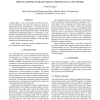Free Online Productivity Tools
i2Speak
i2Symbol
i2OCR
iTex2Img
iWeb2Print
iWeb2Shot
i2Type
iPdf2Split
iPdf2Merge
i2Bopomofo
i2Arabic
i2Style
i2Image
i2PDF
iLatex2Rtf
Sci2ools
ISBI
2007
IEEE
2007
IEEE
Robust Mapping of Brain Surface Meshes onto a Unit Sphere
Complex shapes - such as the surface of the human brain may be represented and analyzed in frequency space by a spherical harmonics transformation. A key step of the processing chain is introducing a suitable parametrization of the triangular mesh representing the brain surface. This problem corresponds to mapping the surface on a unit sphere. An algorithm is described that produces an optimal combination of an area- and angle-preserving mapping. A multi-resolution scheme provides the robustness required to map the highly detailed and convoluted brain surface.
Brain Surface | Convoluted Brain Surface | ISBI 2007 | Medical Imaging | Spherical Harmonics Transformation |
| Added | 03 Jun 2010 |
| Updated | 03 Jun 2010 |
| Type | Conference |
| Year | 2007 |
| Where | ISBI |
| Authors | Frithjof Kruggel |
Comments (0)

